Gorz may refer to:

Gorizia, colloquially stara Gorica 'old Gorizia' to distinguish it from Nova Gorica, is a town and comune (municipality) in northeastern Italy, in the autonomous region of Friuli-Venezia Giulia. It is located at the foot of the Julian Alps, bordering Slovenia. It is the capital of the Regional decentralization entity of Gorizia and is a local center of tourism, industry, and commerce. Since 1947, a twin town of Nova Gorica has developed on the other side of the modern-day Italy–Slovenia border. The region was subject to territorial dispute between Italy and Yugoslavia after World War II: after the new boundaries were established in 1947 and the old town was left to Italy, Nova Gorica was built on the Yugoslav side. The two towns constitute a conurbation, which also includes the Slovenian municipality of Šempeter-Vrtojba. Since May 2011, these three towns have been joined in a common trans-border metropolitan zone, administered by a joint administration board.

Gradisca d'Isonzo is a town and comune (municipality) in the Regional decentralization entity of Gorizia in Friuli-Venezia Giulia, north-eastern Italy. The lawyer, linguist, philologist Philippe Sarchi was born in Gradisca d'Isonzo. It is one of I Borghi più belli d'Italia.

Inner Austria was a term used from the late 14th to the early 17th century for the Habsburg hereditary lands south of the Semmering Pass, referring to the Imperial duchies of Styria, Carinthia and Carniola and the lands of the Austrian Littoral. The residence of the Inner Austrian archdukes and stadtholders was at the Burg castle complex in Graz.
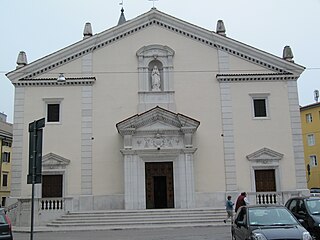
The Archdiocese of Gorizia (Latin: Archidioecesis Goritiensis is a Latin archdiocese of the Catholic Church in Italy. The archiepiscopal see of Gorizia was founded in 1751 when the Patriarchate of Aquileia was abolished, and its territory divided between two new dioceses, Udine and Gorizia. The diocese of Gorizia was suppressed in 1788 for the creation of the Diocese of Gradisca and re-established in 1791 as the Diocese of Gorizia e Gradisca. It was raised again to a metropolitan archdiocese in 1830.
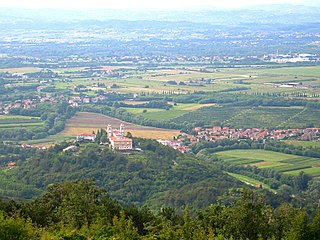
Goriška is a historical region in western Slovenia on the border with Italy. It comprises the northern part of the wider traditional region of the Slovenian Littoral (Primorska). The name Goriška is an adjective referring to the city of Gorizia, its historical and cultural centre.
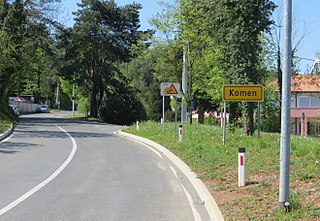
Komen is a settlement in Slovenia. It is the seat of the Municipality of Komen. It is located on the Karst Plateau in the Slovenian Littoral.

The Austrian Littoral was a crown land (Kronland) of the Austrian Empire, established in 1849. It consisted of three regions: the Margraviate of Istria in the south, Gorizia and Gradisca in the north, and the Imperial Free City of Trieste in the middle. The region has been contested frequently, with parts of it controlled at various times by the Republic of Venice, Austria-Hungary, Italy, and Yugoslavia among others.

The Slovene Littoral, or simply Littoral, is one of the traditional regions of Slovenia. The littoral in its name – for a coastal-adjacent area – recalls the former Austrian Littoral, the Habsburg possessions on the upper Adriatic coast, of which the Slovene Littoral was part. Today, the Littoral is often associated with the Slovenian ethnic territory that, in the first half of the 20th century, found itself in Italy to the west of the Rapallo Border, which separated a quarter of Slovenes from the rest of the nation, and was strongly influenced by Italian fascism.

The Princely County of Gorizia and Gradisca, historically sometimes shortened to and spelled "Goritz", was a crown land of the Habsburg dynasty within the Austrian Littoral on the Adriatic Sea, in what is now a multilingual border area of Italy and Slovenia. It was named for its two major urban centers, Gorizia and Gradisca d'Isonzo.

Biagio Marin was a Venetian and Italian poet, best known for his poems in the Venetian language. In his writings he never obeyed rhetoric or poetics. He only employed a few hundred words for his poems.
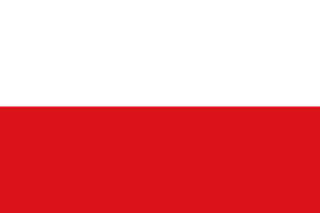
The (Princely) County of Tyrol was an estate of the Holy Roman Empire established about 1140. After 1253, it was ruled by the House of Gorizia and from 1363 by the House of Habsburg. In 1804, the County of Tyrol, unified with the secularised prince-bishoprics of Trent and Brixen, became a crown land of the Austrian Empire. From 1867, it was a Cisleithanian crown land of Austria-Hungary.
Campolongo al Torre is a former comune of the Province of Udine in the Italian region Friuli-Venezia Giulia, located about 40 km northwest of Trieste and about 25 km southeast of Udine. Since 2009 it has been one of the two principal centres of Campolongo Tapogliano, a municipality formed by its merger with the former comune of Tapogliano.

The County of Gorizia, from 1365 Princely County of Gorizia, was a State of the Holy Roman Empire. Originally mediate Vogts of the Patriarchs of Aquileia, the Counts of Gorizia (Meinhardiner) ruled over several fiefs in the area of Lienz and in the Friuli region of northeastern Italy with their residence at Gorizia (Görz).

The Counts of Gorizia, also known as the Meinhardiner, House of Meinhardin, were a comital, princely and ducal dynasty in the Holy Roman Empire. Named after Gorizia Castle in Gorizia, they were originally "advocates" (Vogts) in the Patriarchate of Aquileia who ruled the County of Gorizia (Görz) from the early 12th century until the year 1500. Staunch supporters of the Emperors against the papacy, they reached the height of their power in the aftermath of the battle of Marchfeld between the 1280s and 1310s, when they controlled most of contemporary Slovenia, western and south-western Austria and part of northeast Italy mostly as (princely) Counts of Gorizia and Tyrol, Landgraves of Savinja and Dukes of Carinthia and Carniola. After 1335, they began a steady decline until their territories shrunk back to the original County of Gorizia by the mid 1370s. Their remaining lands were inherited by the Habsburg ruler Maximilian I.

Leonhard was the last count of Gorizia from the Meinhardiner dynasty. He ruled at Lienz and Gorizia (Görz) from 1454 until his death. He also held the title and rights as a count palatine of Carinthia.
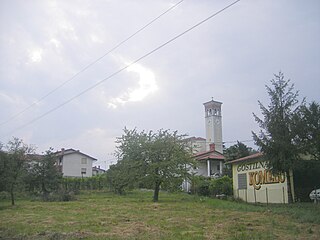
Kromberk is a settlement in the Municipality of Nova Gorica in western Slovenia. Together with its two satellite settlements of Ajševica and Loke, it forms one of the four major suburbs of Nova Gorica.

Gorizia Centrale railway station is the main station serving the town and comune of Gorizia, in the autonomous region of Friuli-Venezia Giulia, northeastern Italy.

The grand title of the emperor of Austria was the official list of the crowns, titles, and dignities which the emperors of Austria carried from the foundation of the empire in 1804 until the end of the monarchy in 1918.

Jakob Missia was a Slovene prelate of the Catholic Church who was Archbishop of Gorizia and Gradisca from 1898 until his death. He was made a cardinal in 1899, the first Slovenian to be given that rank. He was previously Bishop of Ljubljana from 1884 to 1898.
Lukas von Graben zum Stein, lord of Stein, Schwarzenegg and Weidenburg, pledger of Heinfels, was a Carinthian-Gorizian nobleman and military leader of the Counts of Gorizia and the Habsburgs. In the succession dispute over the princely County of Gorizia at the end of the 15th century, Von Graben acted as deputy of his father Virgil von Graben, administrator of Gorizia, and defender of the rights of the Habsburgs against the aspirations of the Republic of Venice. In 1518 he was one of 70 representatives in the first Austrian general parliament of Emperor Maximilian I in Innsbruck.